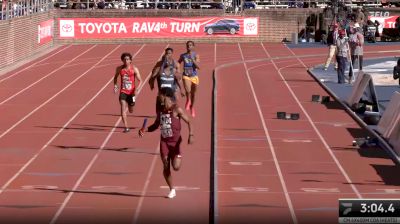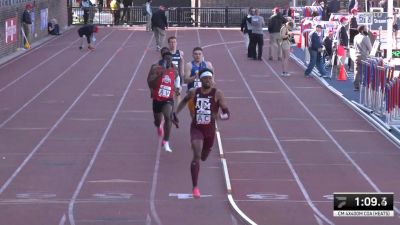Anatomy Of A NCAA Women's Championships XC Team
Anatomy Of A NCAA Women's Championships XC Team
Let's break down the last 20 years of NCAA women's cross country results to identify what it takes to have a title team.

Unlock this article, live events, and more with a subscription!
Already a subscriber? Log In
Last week, we dug into the last 20 years of the men's results from the NCAA Cross Country Championships to identify some commonalities among the championship teams. The analysis didn’t yield definitive rules to win a title, but it did provide some guidelines.
Is it possible to win a championship without a runner in the top 10? Perhaps, but it hasn’t been done yet.
How many runners need to finish in the top 20 for a team to leave victorious? History says three (it’s happened in 19 of the 20 championships).
Will the women follow the same pattern? Let’s take a look and find out:
A few observations:
| Year | Women's Champion | 1st Runner | 2nd Runner | 3rd Runner | 4th Runner | 5th Runner | Score |
| 2017 | New Mexico | 1 | 6 | 9 | 11 | 63 | 90 |
| 2016 | Oregon | 4 | 9 | 16 | 47 | 49 | 125 |
| 2015 | New Mexico | 4 | 5 | 11 | 12 | 17 | 49 |
| 2014 | Michigan State | 4 | 9 | 13 | 16 | 43 | 85 |
| 2013 | Providence | 5 | 16 | 24 | 42 | 54 | 141 |
| 2012 | Oregon | 2 | 3 | 28 | 32 | 49 | 114 |
| 2011 | Georgetown | 3 | 33 | 36 | 44 | 46 | 162 |
| 2010 | Villanova | 1 | 8 | 20 | 22 | 69 | 120 |
| 2009 | Villanova | 6 | 12 | 20 | 22 | 26 | 86 |
| 2008 | Washington | 5 | 9 | 19 | 20 | 26 | 79 |
| 2007 | Stanford | 8 | 27 | 30 | 37 | 43 | 145 |
| 2006 | Stanford | 3 | 27 | 45 | 58 | 62 | 195 |
| 2005 | Stanford | 7 | 15 | 19 | 35 | 70 | 146 |
| 2004 | Colorado | 2 | 9 | 10 | 20 | 22 | 63 |
| 2003 | Stanford | 3 | 6 | 20 | 23 | 68 | 120 |
| 2002 | BYU | 4 | 6 | 15 | 28 | 32 | 85 |
| 2001 | BYU | 5 | 7 | 9 | 20 | 21 | 62 |
| 2000 | Colorado | 1 | 7 | 23 | 38 | 48 | 117 |
| 1999 | BYU | 8 | 13 | 14 | 17 | 20 | 72 |
| 1998 | Villanova | 10 | 11 | 15 | 18 | 52 | 106 |
| Average | 4.3 | 11.9 | 19.8 | 28.1 | 44 | 108.1 |
-Like the men, a championship women's team always has at least one runner in the top 10 of the meet. A low-stick was even more necessary in the past eight years when the winning squad had at least one finisher in the top eight.
-The average winning score for a men’s team is 83 points, while the women’s champion has an average of 108. This is mirrored in the individual places where the women’s finishers were behind the men when comparing all five scoring runners.
Men: #1 3.65
#2 7.1
#3 11.85
#4 23.1
#5 37.35
Women: #1 4.3
#2 11.9
#3 19.8
#4 28.1
#5 44
The cause of this is open to interpretation. Perhaps the top men’s runners cluster themselves more in top programs, creating “super teams.” Or, the women’s 6K distance allows for more parity.
But just because the winning score has been considerably lower, doesn’t mean the race has been less competitive. The average men’s margin of victory was 46.5 points, while women’s winners were 41.45 better than second place. A difference, but not a dramatic one.
-While the top runner finished anywhere between first and 10th, there was a wide range for each team’s second woman across the line.
Oregon won the 2012 national championship with their second scoring runner scoring three points, leading them to a resounding 69-point victory over Providence. The year before, Georgetown took the title with their second runner scoring 33 points.
-For the men, four All-Americans was a prerequisite. This is basically true for the women although four past champions have had their number four runner finish outside of the top 40. The 2006 Stanford squad is the only championships team to only have two inside the first 40. That team scored 195 points, the highest in the history of the meet.
Related Content
 Houston Track And Field At Penn Relays 2024: UH Results And Schedule
Houston Track And Field At Penn Relays 2024: UH Results And ScheduleApr 26, 2024
 Harvard Track And Field At Penn Relays 2024: Crimson Results And Schedule
Harvard Track And Field At Penn Relays 2024: Crimson Results And ScheduleApr 26, 2024
 Texas A&M Track And Field At Penn Relays 2024: A&M Results And Schedule
Texas A&M Track And Field At Penn Relays 2024: A&M Results And ScheduleApr 26, 2024
 Penn Relays 2024 Results On Day 2: See Which NCAA Stars Won
Penn Relays 2024 Results On Day 2: See Which NCAA Stars WonApr 26, 2024
 High School Track And Field Penn Relays 2024 Results Through Day 2
High School Track And Field Penn Relays 2024 Results Through Day 2Apr 26, 2024
 Texas A&M Anchor Auhmad Robinson Toys With The Competition In 4x400
Texas A&M Anchor Auhmad Robinson Toys With The Competition In 4x400Apr 26, 2024
 Men's 4x400m Relay Coa, Event 356, Prelims 3
Men's 4x400m Relay Coa, Event 356, Prelims 3Apr 26, 2024
 Men's 4x400m Relay Coa, Event 356, Prelims 2
Men's 4x400m Relay Coa, Event 356, Prelims 2Apr 26, 2024
 Men's 4x400m Relay Coa, Event 356, Prelims 1
Men's 4x400m Relay Coa, Event 356, Prelims 1Apr 26, 2024